

Calit2 awards $200,000 to five data sharing projects. The University of San Diego’s California Institute for Telecommunications and Information Technology’s (Calit2) data sharing initiative, called Health Data Exploration (HDE), has awarded a total of $200,000 to five projects that aim to use aggregated personal health data to advance research.
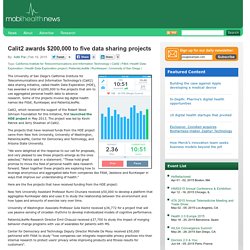
Some of the projects involve big digital health names like Fitbit, RunKeeper, and PatientsLikeMe. Calit2, which received the support of the Robert Wood Johnson Foundation for this initiative, first launched the HDE project in May 2013. The project was led by Kevin Patrick and Jerry Sheehan of Calit2. The projects that have received funds from the HDE project came from New York University, University of Washington, PatientsLikeMe, Center for Democracy and Technology, and Arizona State University. How Theory Matters: Benjamin, Foucault, and Quantified Self—Oh My! Jamie Sherman, Intel Corporation.
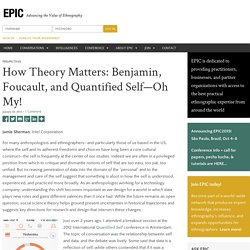
In-Depth: Revisiting Topol’s Top Ten Digital Health Targets. Five years ago this month, Scripps Health’s Chief Academic Officer Dr.
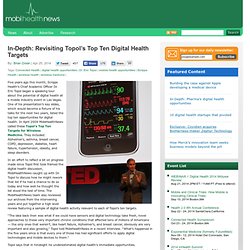
Eric Topol began a speaking tour about the potential of digital health at a mobile industry event in Las Vegas. One of his presentation’s key slides, which would become a fixture of his talks for the next two years, listed the top ten opportunities for digital health. In April 2009 MobiHealthNews called these Topol’s Top Ten Targets for Wireless Medicine. Critique "Every Breath You Take" It started in the ‘70s.
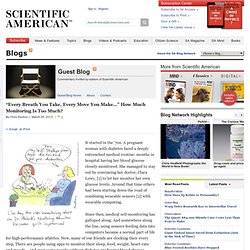
A pregnant woman with diabetes faced a deeply entrenched medical routine: months in hospital having her blood glucose closely monitored. She managed to stay out by convincing her doctor, Clara Lowy, [1] to let her monitor her own glucose levels. Around that time others had been starting down the road of combining wearable sensors [2] with wearable computing. Since then, medical self-monitoring has galloped along.
QS Right to data. Photo by Mike Segar/Reuters This article is part of Future Tense, a collaboration among Arizona State University, the New America Foundation, and Slate.
On Thursday, Nov. 14, Future Tense will host an event on how technology affects obesity at the New America office in Washington, D.C. Self knowledge through numbers. Lupton / cultural phenomenon. The Quantified Self movement was first developed in 2007 by two Wired Magazine editors, Gary Wolf and Kevin Kelly, who set up a website devoted to the movement in 2008.
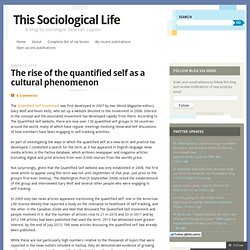
Interest in the concept and the associated movement has developed rapidly from there. According to The Quantified Self website, there are now over 130 quantified self groups in 34 countries around the world, many of which have regular meetings involving ‘show-and-tell’ discussions of how members have been engaging in self-tracking activities. As part of investigating the ways in which the quantified self as a new term and practice has developed, I conducted a search for the term as it has appeared in English-language news media articles in the Factiva database, which archives newspaper and magazine articles (including digital and print articles) from over 8,000 sources from the world’s press.
Natasha Schull. Dorien. Still from the Poikos FlixFit body measure app, shown by Nell Watson at Amsterdam Quantified Self Conference 2013 [Full view] 'Quantified Selfers' are people who spend a lot of their time tracking, measuring and counting physical, mental and emotional aspects of their 'selves'.
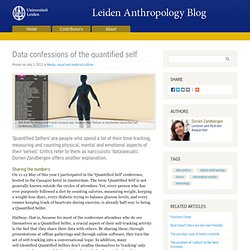
Critics refer to them as narcissistic 'datasexuals'. Dorien Zandbergen offers another explanation. Sharing the numbers. Nafus_Kleenex. (Note: Jamie Sherman and I wrote this text together as an experiment in mixing academic and popular writing styles.
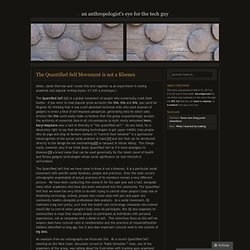
Relational sociology. There has been a lot of “buzz” around Quantified Self (QS) and self-tracking technologies recently and I just wanted to put down some ideas from a personal perspective as someone who runs frequently and tracks his progress regularly.

Inviting Judgement: A Note On Everyday Life, Eating and Smartphone Apps. I recently purchased an iPhone for the purpose of researching an app called The Eatery.
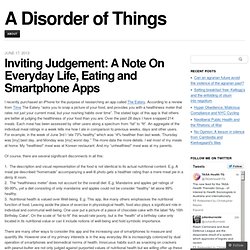
According to a review from Time The Eatery “asks you to snap a picture of your food, and provides you with a healthiness meter that rates not just your current meal, but your noshing habits over time”. The stated logic of this app is that others are better at judging the healthiness of your food than you are. Over the past 28 days I have snapped 214 meals. Lupton / article. I have published several posts on this blog now about mHealth and the quantified self (see them here).
I have also written two scholarly publications that have been published in academic journals discussing this topic in greater depth. In the first article I looked at how theories of surveillance society and the cyborg body could be applied to understanding the use of digital health technologies as they are used for health promotion, and also discussed privacy, intimacy and ethical issues (see here for details of the first article, the full version of which is open access).
The latest article is entitled ‘Quantifying the body: monitoring, performing and measuring health in the age of mHealth technologies’, published in Critical Public Health (see here for details). It builds upon the previous article by bringing in discussion of the quantified self movement. Intel - QS. A few years ago I was guinea pig for an Intel Labs study. I attached three sensors to my body for a week: a pedometer on my belt, a heart rate monitor strapped around my chest, and a galvanic skin response detector (stress or “lie” detector) taped to one of my fingers. The Transfigure Project. “His eyes are staring, his mouth is open, his wings are spread. This is how one pictures the angel of history. His face is turned toward the past. Where we perceive a chain of events, he sees one single catastrophe which keeps piling wreckage upon wreckage and hurls it in front of his feet. The angel would like to stay, awaken the dead, and make whole what has been smashed.
But a storm is blowing from Paradise; it has got caught in his wings with such violence that the angel can no longer close them. Data or debris?